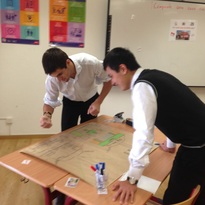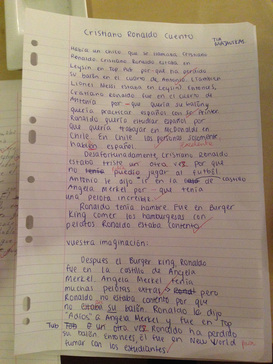

fun in Spanish class doing a 'running dictation'.
Let me know your thoughts on Twitter @liamprinter
 Students sit all day and sitting for hours on end is exhausting. We as teachers are up and walking around continuously so we (at least most of the time) manage to stay awake while we teach. Yet we wonder why our students lose interest, stop concentrating, glaze over and zone out when we are half way through a riveting explanation of demonstrative pronouns. It's because they are sedentary, passive agents in the learning process when we keep them in their seats in a warm room listening to us ramble on.  After studying the benefits of 'Active and Cooperative Learning' while completing my Teaching Qualifications, I've always tried to have an active classroom. To me at least, the benefits are clear - engagement is improved, students receive context with new language structures, they aren't falling asleep or glazing over with the "I hear your words but am not listening in the slightest" look and above all, in most cases, the students are smiling, laughing and having fun. In my view, if students are laughing and having fun then at least they will find it really challenging to hate your subject and your class. Even if they have zero interest in quadratic equations or ox-bow lakes, if they know they'll be moving around, laughing and having fun in your class then at least they will not resent the fact that they have to be there. Once this has been achieved you may even get them to like the subject a little and who knows they might even learn something once you've got that far! Video: All students moving around, fully engaged, awake, concentrating and having fun in Spanish class doing a 'running dictation'. My views on 'student movement is the key' were copper-fastened when I read Grant Wiggin's excellent blog post here. The veteran teacher shadowed students all week and his number 1 key takeaway was that "sitting is exhausting" and students need to get up and move in every class. Furthermore, last week we were lucky enough to have the wonderful Lisa Lee visit our school and give us her TEDx Talk on "Getting at the heart of teaching" where she also waxed lyrical about the vital importance of student movement in the classroom. The next time you see that I'm glazing over look start to appear on your students faces just think of any way you can get them to 'GUAM' (Get Up And Move). It might be the simplest thing like "Ok guys stand up and go and sit with someone new. Now compare your work with what they have". A simple 5 second instruction that will take about 30 seconds of your class teaching time but could save you hours of repeating yourself later and wondering why they didn't get it when you explained it 'so perfectly' the first time!
Let me know your thoughts on Twitter @liamprinter
1 Comment
 Spanish students writing structures from story Spanish students writing structures from story TPRS stands for 'Teaching Proficiency Through Storytelling' and basically it uses stories with lots of repetitions of key structures to teach fluency rather than detailed vocabulary lists. It is based on the theory of 'comprehensible input' which fundamentally outlines that to learn a language you need 'input' (words written and spoken) on repeated occasion in an understandable format. I was first introduced to it last year in our language department here at Leysin American School. I'm not going to lie, when I first watched the 'over the top' teaching of TPRS Godfather Blaine Ray, I was a bit skeptical but the other teachers in my department loved it so I gave it a shot. At first it was nothing short of a disaster. I felt exhausted and flustered throughout the lesson and I think my students simply thought I'd taken the wrong pills that morning. But I persisted with the help of other teachers in the department and we then received two separate training sessions on the approach, one from Blaine Ray himself and another from Beth Skelton. I was hooked. After just 35 minutes of mandarin I was able to read and understand a full page of text and say various key sentences like "I need", "Have you got", "Where is" etc and I could understand more than 95% of someone speaking only in mandarin. After just 35 minutes! It really blew me away.  Spanish 1 TPRS story by student Spanish 1 TPRS story by student If this is the first time you've heard of it you should take a look at Blaine's videos, follow Beth Skelton on twitter and check out Martina Bex's site too. I've never used any other method that worked so well at embedding difficult grammar. I've just spent the last two weeks doing a story with my Spanish 1 class about a guy who was lazy, and used to only sunbathe and watch TV, but then he went to the house of the Aunt of Jennifer Lopez and suddenly became a fitness freak. He went to the Olympics in Puerto Rico and won every gold medal before wanting to participate in a Taco eating contest with... well with Jennifer Lopez's auntie... of course! This was all done in the past tense using a mix of 'preterito indefinido' and 'imperfecto' and the students can all tell me that story now using those structures and speaking about their own life with the same structures. Here is a picture of a previous story we did 3 weeks ago written as homework by a student. No google translator, no outside help. Simply a method that repeats the key structures with memorable silly details. Trust me, it works. Please leave me your comments on get in touch on twitter here or tweet @liamprinter |
AuthorDr. Liam Printer: Archives
May 2022
Categories
All
|